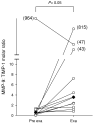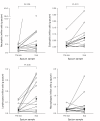MMP-9, TIMP-1 and inflammatory cells in sputum from COPD patients during exacerbation
- PMID: 16372907
- PMCID: PMC1351193
- DOI: 10.1186/1465-9921-6-151
MMP-9, TIMP-1 and inflammatory cells in sputum from COPD patients during exacerbation
Abstract
Background: Irreversible airflow obstruction in Chronic Obstructive Pulmonary Disease (COPD) is thought to result from airway remodelling associated with aberrant inflammation. Patients who experience frequent episodes of acute deterioration in symptoms and lung function, termed exacerbations, experience a faster decline in their lung function, and thus over time greater disease severity However the mechanisms by which these episodes may contribute to decreased lung function are poorly understood. This study has prospectively examined changes in sputum levels of inflammatory cells, MMP-9 and TIMP-1 during exacerbations comparing with paired samples taken prior to exacerbation.
Methods: Nineteen COPD patients ((median, [IQR]) age 69 [63 to 74], forced expiratory volume in one second (FEV1) 1.0 [0.9 to 1.2], FEV1% predicted 37.6 [27.3 to 46.2]) provided sputa at exacerbation. Of these, 12 were paired with a samples collected when the patient was stable, a median 4 months [2 to 8 months] beforehand.
Results: MMP-9 levels increased from 10.5 microg/g [1.2 to 21.1] prior to exacerbation to 17.1 microg/g [9.3 to 48.7] during exacerbation (P < 0.01). TIMP-1 levels decreased from 3.5 microg/g [0.6 to 7.8] to 1.5 microg/g [0.3 to 4.9] (P = 0.16). MMP-9/TIMP-1 Molar ratio significantly increased from 0.6 [0.2 to 1.1] to 3.6 [2.0 to 25.3] (P < 0.05). Neutrophil, eosinophil and lymphocyte counts all showed significant increase during exacerbation compared to before (P < 0.05). Macrophage numbers remained level. MMP-9 levels during exacerbation showed highly significant correlation with both neutrophil and lymphocyte counts (Rho = 0.7, P < 0.01).
Conclusion: During exacerbation, increased inflammatory burden coincides with an imbalance of the proteinase MMP-9 and its cognate inhibitor TIMP-1. This may suggest a pathway connecting frequent exacerbations with lung function decline.
Figures





Similar articles
-
[Metalloproteinase-9/tissue inhibitor of metalloproteinase-1 in induced sputum in patients with asthma and chronic obstructive pulmonary disease and their relationship to airway inflammation and airflow limitation].Zhonghua Jie He He Hu Xi Za Zhi. 2007 Mar;30(3):192-6. Zhonghua Jie He He Hu Xi Za Zhi. 2007. PMID: 17572998 Chinese.
-
Clinical study of inflammatory factors in sputum induced early after lung volume reduction surgery.Chin Med J (Engl). 2008 Sep 20;121(18):1796-9. Chin Med J (Engl). 2008. PMID: 19080360
-
[Relationships between the expressions of intercellular adhesion molecule-1 and tissue inhibitor of metalloproteinase-1 and matrix metalloproteinase-9 in lung tissues of patients with chronic obstructive pulmonary disease].Zhonghua Jie He He Hu Xi Za Zhi. 2008 Feb;31(2):129-33. Zhonghua Jie He He Hu Xi Za Zhi. 2008. PMID: 18683786 Clinical Trial. Chinese.
-
Exacerbations of chronic obstructive pulmonary disease.Respir Care. 2003 Dec;48(12):1204-13; discussion 1213-5. Respir Care. 2003. PMID: 14651761 Review.
-
The Relationship between Airway Inflammation and Exacerbation in Chronic Obstructive Pulmonary Disease.Tuberc Respir Dis (Seoul). 2017 Oct;80(4):325-335. doi: 10.4046/trd.2017.0085. Epub 2017 Sep 4. Tuberc Respir Dis (Seoul). 2017. PMID: 28905537 Free PMC article. Review.
Cited by
-
Cigarette smoke-induced collagen destruction; key to chronic neutrophilic airway inflammation?PLoS One. 2013;8(1):e55612. doi: 10.1371/journal.pone.0055612. Epub 2013 Jan 31. PLoS One. 2013. PMID: 23383243 Free PMC article.
-
Oestrous cycle-dependent equine uterine immune response to induced infectious endometritis.Vet Res. 2016 Nov 8;47(1):110. doi: 10.1186/s13567-016-0398-x. Vet Res. 2016. PMID: 27825391 Free PMC article.
-
Alternative Oxidase Attenuates Cigarette Smoke-induced Lung Dysfunction and Tissue Damage.Am J Respir Cell Mol Biol. 2019 May;60(5):515-522. doi: 10.1165/rcmb.2018-0261OC. Am J Respir Cell Mol Biol. 2019. PMID: 30339461 Free PMC article.
-
Evaluation of surfactant proteins A, B, C, and D in articular cartilage, synovial membrane and synovial fluid of healthy as well as patients with osteoarthritis and rheumatoid arthritis.PLoS One. 2018 Sep 20;13(9):e0203502. doi: 10.1371/journal.pone.0203502. eCollection 2018. PLoS One. 2018. PMID: 30235245 Free PMC article.
-
T cell senescence and contraction of T cell repertoire diversity in patients with chronic obstructive pulmonary disease.Clin Exp Immunol. 2009 Mar;155(3):466-75. doi: 10.1111/j.1365-2249.2008.03835.x. Clin Exp Immunol. 2009. PMID: 19220836 Free PMC article.
References
-
- Betsuyaku T, Nishimura M, Takeyabu K, Tanino M, Venge P, Xu S, Kawakami Y. Neutrophil granule proteins in bronchoalveolar lavage fluid from subjects with subclinical emphysema. Am J Respir Crit Care Med. 1999;159:1985–1991. - PubMed
Publication types
MeSH terms
Substances
LinkOut - more resources
Full Text Sources
Other Literature Sources
Medical
Research Materials
Miscellaneous

